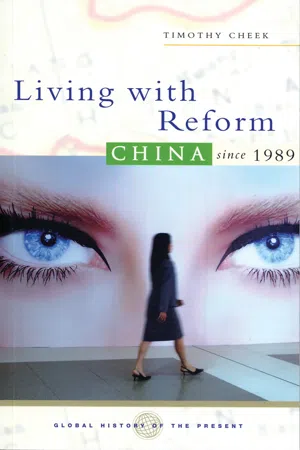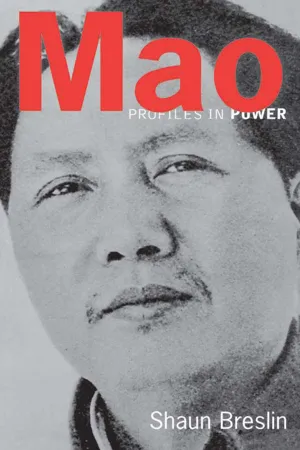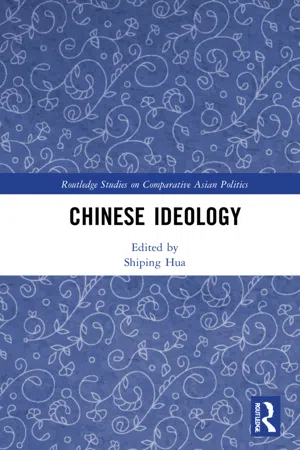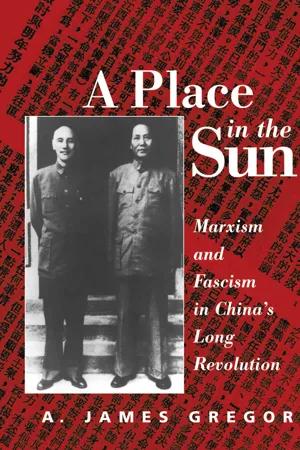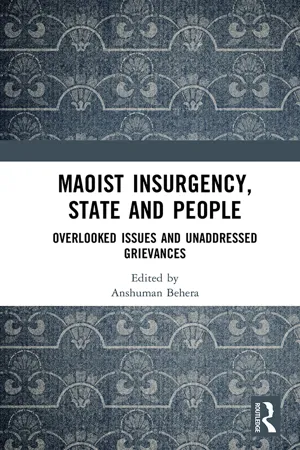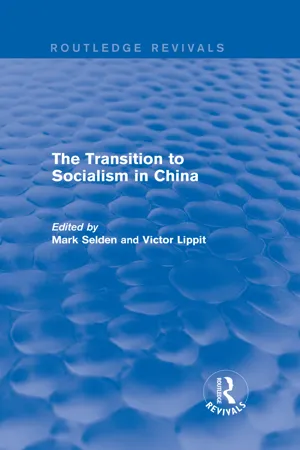Politics & International Relations
Maoism
Maoism is a political theory and practice developed by Chinese leader Mao Zedong. It emphasizes revolutionary struggle and the empowerment of the peasantry, advocating for a classless society and the continuous revolution to prevent the rise of a new ruling class. Maoism also promotes self-reliance, anti-imperialism, and the belief in the potential for rural areas to lead revolutionary change.
Written by Perlego with AI-assistance
Related key terms
9 Key excerpts on "Maoism"
- eBook - ePub
Living with Reform
China since 1989
- Timothy Cheek(Author)
- 2013(Publication Date)
- Zed Books(Publisher)
These contrasting realities – a socialist state and a capitalist economy – bump up against each other in daily life in China. Contemporary Chinese society is itself framed by two systems. The first is the physical and human geography that we met in the previous chapter – the stunning diversity that exists under the hegemonic belief that there is a unitary China (shared by most of the population as well as asserted by the political leadership). The realities and rules of local culture, kinship, patriarchy, and personal networks shape the experience and expectations of each member of this diverse population that calls itself Chinese. The forms that these diverse norms and practices take today, however, have been fundamentally shaped by one common experience: Maoism.Living Maoism is the second system that frames social life in the People’s Republic of China today. It is the mental world shared across vast differences of city and village, rich and poor, Han and minority, man and woman, young and old. Each distinct person and social group brings its own meanings to this mental world, and contributes to its transformation, but the tools they use to support the Party, ignore it or oppose it are the ideas, assumptions, and habits of Maoism.Maoism is an ongoing dynamic in contemporary China. Officially, Maoism is the writings and ideas of Mao Zedong, the undisputed leader of the CCP since the 1940s and the founding leader of the People’s Republic until his death in 1976. It is properly known as ‘Marxism-Leninism-Mao Zedong Thought,’ and remains the official ideology of both the CCP and the constitution of the PRC. All government policies, and much cultural and academic work, as well as formal laws and regulations, explicitly invoke this ideology. It is the public doctrine of China.Over the past fifty years political Maoism has created both social practices and profound habits of thought. These two things – official Maoist ideology and the social life of state socialism with its enduring habits of thought (assumptions, values, ways of reasoning) – comprise the living history of Maoism. That living history shapes the production of reform policies by the state leadership, the application of those policies by local government and business leaders, and the experience of these reforms in practice by ordinary people in China. The operation of this living history of Maoism is quite complex, and often surprising. The official ideology is no longer widely believed. Cynicism about Party pronouncements is rife. Yet it defines the field of public debate, if only by providing the terms of reference. Party intellectuals, reformers of various stripes, and even dissidents all avail themselves of the language, ideas, and terms found in Mao’s Thought to debate public policy. The social structures of state socialism and the lifeways they produced continue to influence life on the ground even as those structures are changed. The residential passport system (hukou) and the work unit system (danwei) still shape capitalist enterprises even as the harsher aspects of these two systems have been abandoned to be replaced by the insecurities and inequalities of the market. Most fundamentally, the habits of thought and practices of public life that emerged under ‘actually existing Maoism,’ particularly in the destructive Cultural Revolution decade of 1966–76, shape the expectations and ways of making a point among most people in China.1 - eBook - ePub
China's Education and the Industrialised World
Studies in Cultural Transfer
- Ruth Hayhoe, Marianne Bastid, Ruth Hayhoe, Marianne Bastid(Authors)
- 2017(Publication Date)
- Routledge(Publisher)
2 constitutes a kind of historical enigma which might be explained in two opposite ways.On the one hand, Maoism could be regarded as an imported ideology. In spite of effective forms of propaganda and a favorable environment, this transplant was rejected because of its foreign origins. Western democracy was able to resist what was essentially an enterprise of disinformation, even subversion.3 In the first section of this chapter, I discuss the network of Chinese organizations in France and their impact.On the other hand, Maoism could be seen as a brief, feverish infatuation of the European intelligentsia, which was more naive and uninformed than ill-intentioned. The Cultural Revolution became a fashion for writers and journalists who were disappointed with the evolution of a world they did not understand. These idealists propagated the myth of a new China, using Chinese terms and colors, yet remaining fundamentally true to the western utopian tradition. The “myth of the educative society,” discussed in section two, represented the rebirth of the ancient European vision of an Ideal City under the guise of what I am calling Maolatry.Maoism was also a cultural phenomenon which provided a new language to the western intellectual elite in a time of ferment when value systems, institutions and behaviors were subject to radical questioning. Its dynamism and ultra-democratic spirit stood out in sharp relief against a Western society perceived as reified and technocratic. Section three of this chapter explores the way in which Maoism affected the new, enlarged cohort of university youth, especially those in the social sciences.Finally, in the fourth section, I consider the Maoist organizations themselves, their impact on school reform, on pedagogical models, and on the sociology of education. In conclusion, I ask whether there are not some parallels between the Jesuits and the European Maoists in their admiration of a China that is always being rediscovered. - sine qua non for all policy.. . .
Mao's Political Ideas: Revolutionary Purity or Political Pragmatism?
It is notable that Mao’s emphasis on ideology and politics reflected those areas where he was most able to set the political agenda. His ideas were not particularly strongly held within the party-state bureaucracy. As Lieberthal notes:It was thus to his advantage to maintain the primacy of the ideological debate and focus on those areas where his voice was most likely to be heard.Mao’s own position in the system would be affected by the type of economic development strategy pursued. The Chairman’s personal political strengths lay in the areas of foreign policy (especially towards the great powers), rural policy, and issues of revolutionary change.15Furthermore, Mao’s prestige was high amongst the rural masses and the young, partly as a consequence of the mass mobilisation campaigns and the development of the personality cult that will be discussed in detail in the next chapter. Again, it played to his strengths to emphasise the primacy of rural development. With the Leninists dominating policy-making, subjecting them to supervision and control from the masses who were more sympathetic to Mao’s views was also to his political benefit. Similarly, promoting party entrance for those who were politically active created a new pro-Mao constituency in the party to challenge the existing status quo and the technocratic party membership.Another consideration here is the relationship between Mao’s goals for the Chinese revolution and the influence of Soviet Marxism. The extent to which Mao ever had a firm and good grasp of the canon of Marx and Engels is open to question. It certainly appears that he came to the original works after - eBook - ePub
- Shiping Hua, Shiping Hua(Authors)
- 2021(Publication Date)
- Routledge(Publisher)
Part 3Maoism as an ideology
Passage contains an image
Aminda Smith10 The living soul of Mao Zedong ThoughtDOI: 10.4324/9781003007364-10Mao Zedong was the Chairman of the Chinese Communist Party (CCP) for more than 30 years. After leading the revolution that established the People’s Republic of China (PRC) in 1949, Mao was the PRC’s supreme leader and the CCP’s paramount theorist until his death in 1976. He is known for his radical, inspiring, and often disastrous leadership. In the Soviet Union Vladimir Lenin was venerated as the visionary Marxist theorist who led the revolution, whereas his successor, Joseph Stalin, was known as the autocrat who tried to keep Russia on the socialist path. But in the People’s Republic, Mao alone is remembered as the military commander who toppled pre-revolutionary regimes, the theorist who adapted Marxism to China, and the supreme leader who presided over the PRC’s transformation into the world’s largest communist country. Thanks to his “cult of personality,” Mao became a global icon, whose image appeared on buttons, books, alarm clocks, architecture, and more. A portrait of Mao by Andy Warhol sold for nearly 50 million dollars in 2015.Mao has always been a controversial figure. In China, he is remembered by some as a champion of the poor; others revile him as a tyrant; still others view his leadership as a necessary, if tragic, step toward China’s rise as a world power. International impressions of Mao are equally diverse. Some people still revere him for the revolutionary inspiration he gave to anti-colonial and anti-capitalist movements around the globe. Others place him in a notorious trifecta of the most monstrous leaders in world history: Hitler, Stalin, Mao. How can we explain such divergent opinions? Part of the answer is that Mao, like all people, changed over time. Additionally, his ideas, at every stage of his life, were more appealing to some people than others. Finally, and most importantly, how one evaluates Mao depends on how one understands what constitutes justice, what counts as liberty, and whether, how, and at what cost, people should try to create revolutionary change. - eBook - ePub
A Place In The Sun
Marxism And Fascimsm In China's Long Revolution
- A. James Gregor(Author)
- 2019(Publication Date)
- Routledge(Publisher)
Ideology and Development: Sun Yat-sen and the Economic History of Taiwan (Berkeley: Center for Chinese Studies, 1981), chap. 1.17. See Liu Suinian and Wu Qungan, China’s Socialist Economy: An Outline History (1949–1984) (Beijing: Beijing Review, 1986), pts. 1–2; see pp. 172–173.18. See Mao Zedong, A Critique of Soviet Economics (New York: Monthly Review Press, 1977).19. Of the twenty-three members of the politburo of the CCP before the Proletarian Cultural Revolution, only nine retained membership. Approximately two-thirds of the members of the CCP Central Committee elected in 1956 were purged. A large majority of the leaders of the CCP who had exercised leadership during the first two decades of Mao’s rule were publicly disgraced, including his heir apparent, Liu Shaoqi.20. Different factions in the party emphasized different threats. Lin Biao had identified the United States as China’s principal antagonist and apparently sought realignment with the Soviet Union to offset the threat.21. See the discussion in A. James Gregor, The Fascist Persuasion in Radical Politics (Princeton: Princeton University, 1974), chap. 6.22. The Chinese press during the Great Proletarian Cultural Revolution was filled with these charges. An easily available English-language rendering is found in Martin Nicolaus, Restoration of Capitalism in the USSR (Chicago: Liberator, 1975).23. See the discussion in A. Zelochovtsev, La Rivoluzione Culturale vista da un sovietico (Milan: Rusconi, 1971).24. See Boris Leibson, Petty-Bourgeois Revolutionism (Anarchism, Trotskyism and Maoism) (Moscow: Progress, 1970); V. Krivtsov, ed., Maoism Through the Eyes of Communists (Moscow: Progress, 1970).25. O. E. Vladimirov, ed., Maoism As It Really Is (Moscow: Progress, 1981), pp. 7, 9–11, 24, 28, 30–31, 34, 38.26. V. A. Krivtsov and V. Y. Sidikhmenov, A Critique of Mao Tse-tung’s Theoretical Conceptions - eBook - ePub
Contemporary China
A History since 1978
- Yongnian Zheng, Yongnian Zheng(Authors)
- 2013(Publication Date)
- Wiley-Blackwell(Publisher)
In the early 1960s, Mao began to have serious doubts about Liu. The “two-front” leadership arrangement led to a situation in which Mao perceived that he was increasingly marginalized in decision-making. By 1965, Mao had completely lost confidence in Liu and decided to have him removed. In 1966, Mao managed to install Lin Biao as the new successor with the support of another personal favorite whom he seemingly regarded as totally loyal, and the support of the army for the unprecedentedly disruptive CR. Once reluctantly installed as the successor, Lin essentially adopted the passive tactic of echoing whatever positions Mao adopted. This involved fulsome praise of the CR. Nevertheless, by 1970, Mao had come to doubt and took precautionary measures against his successor. Conflicts involving turf warfare and petty personal frictions unfolded between civilian radicals led by Madam Mao (Jiang Qing) and a group involving Lin’s household, particularly his wife and son, and top central military officials from among his revolutionary colleagues. Sensing that the military had gathered too much power, Mao sided with his wife at the 1970 Lushan Plenum and demanded self-criticisms from Lin’s group, which he found inadequate. This eventually forced a showdown with Lin that led to the latter’s fateful flight from China in September 1971.In the post-Lin Biao conflict of the radicals around Jiang Qing against the remaining pre-CR elite represented by Zhou Enlai, and after his 1973 rehabilitation by Deng Xiaoping, Mao considered a range of younger leaders as eventual successors, particularly the radical Wang Hongwen, and eventually Hua Guofeng, who also had support from veteran revolutionaries for such a role.Mao used power struggle as an incentive for other leaders in order to achieve his political goal. As a major player in all these power struggles, he was able to manipulate these political factions. He frequently changed his political alliances to eliminate any perceived political threat to his authority and move toward his goal. He was able to maneuver since his authority was absolute. With his passing, his political enterprise faded with him.Maoism: Experiment and Failure
Maoism is undoubtedly one of the greatest experiments in human history. Like Dr Sun Yat-sen and Chiang Kai-shek before him, Mao was aware of the importance of having a strong state. Nonetheless, it was never clear what form of a strong state Mao had attempted to build. He was never satisfied with the form of the state his revolution had brought about. Whereas states rest on bureaucratic systems, Mao’s form of the state was one without a bureaucratic system. He thus called for a continuous revolution to consistently remake the state.The Party-state was successful in establishing a hegemonic regime and an overall control over local society through its coercive organization and ideology. The domination of the state, however, does not necessarily mean that the state is able to modernize the country. The state’s capacity to develop the economy and society depends on not only the will and skill of the top leadership, but also the lower-level state organizations and social institutions. Without the initiative of social institutions and the cooperation of lower-level organizations, leaders will have difficulties mobilizing people and getting them to rally behind them. - eBook - ePub
Maoist Insurgency, State and People
Overlooked Issues and Unaddressed Grievances
- Anshuman Behera, Anshuman Behera(Authors)
- 2023(Publication Date)
- Routledge India(Publisher)
2015 ). In a normative sense, ideology should not be confused with dogma. A closer look at the Marxist-Leninist-Maoist revolutionary tradition reveals that the three magic weapons that Mao Tse Tung prescribed for the Chinese revolution are absent from the writings of Marx and Lenin. This reflects on the creative application of a universal ideology in, what Mao says, “concrete conditions.” In this sense, an ideology of an insurgency should not be guided by mere pragmatism, which offers short-term achievements. A static view of ideology often overlooks the local specificities. The Maoist insurgency movement, one of the oldest, claims to adopt a Marxist-Leninist-Maoist (MLM) revolutionary ideological framework. However, if it were the mere imposition of this ideological framework without creatively applying it in the Indian context, the movement would have experienced much more difficulties. The following section makes sense with the adoption, application, and development (if at all) of ideology by the Maoists in India.In the process of reasoning with the ideology of the Maoist insurgency, one would observe that the ideological position of the Maoists, at various stages of their movement, has been determined by the historical context and socio-political specificities. A meaningful way to understand the ideology of the Maoists could be through its longstanding ideological struggle in interacting with the international situation and, at the same time, constantly responding to the conditions (socioeconomic) in India. Though the popular discourse reflects on the Maoists adopting a Marxist-Leninist-Maoist ideological framework, the Maoists have had massive disagreements on ideology, especially after the death of Charu Majumdar in 1972. As factionalism dominated as an important feature of the armed Communist movements in India, the absence of an ideological commonality was observed in the 1970s and early 1980s. Reflecting on the ideological differences among the various factions of Indian Maoists, the leader of the Unity Center of Communist Revolutionaries of India (UCCRI), one of the significant Maoist factions, Nagi Reddy, said that:Communists in India were almost entirely without any independence of thought. A high degree of dependence manifested itself from the very start, so the wrong lines from the internationalist movement disproportionately impacted the movement. At first, it was M N Roy and CPGB. Then mechanically applying what they were told, Joshi followed the Zinoviev-Kamanev-Rykov line, Ranadive the Tito line, Ajoy Ghosh the Khruschev line, the CPI (M) the Liu Shao-Chi line, and the CPI-ML under Charu Majumdar the Lin Piao line. Just as the leaders depended on outsiders, they encouraged their cadres to depend on them. The cadres were told to follow what the leaders said, not to waste time reading too much, and to worry about discussion, but simply follow the guidelines and policies that come from above. - eBook - ePub
Marxism and the Making of China
A Doctrinal History
- J. Gregor(Author)
- 2014(Publication Date)
- Palgrave Macmillan(Publisher)
In the primitive economic environment that is the natural seedbed of reactive nationalism, only few possess the skill set required of revolutionary leadership. Revolutions in such circumstances are led by exiguous minorities leading inarticulate masses. While Stalinism shared the general configuration of the class of reactive, developmental nationalism, its unique properties were to prove equally important, for they were to shape the future of both the Soviet Union and the People’s Republic of China in ways that were totally unanticipated.In the reactive nationalist revolutions of the nineteenth and twentieth centuries, Socialism was no longer a function of the abundance provided by advanced industry. It is pursued in the most parlous circumstances. In preindustrial environs, national liberation does not require the availability of a schooled and responsible urban working class to democratically manage a complex productive system. People would be liberated by informed elites who would introduce the requisite revolutionary consciousness from without. The appropriate consciousness becomes the exclusive concern of the hegemonic, unitary party and its leadership. The political party emerges as the demiurge of world history—and its leadership assumes the burden of mastery—with the providential leader at the helm. The “cult of personality” becomes its predictable byproduct, with political religion its inspiration.74 Out of just those constituents, Maoism made its fulsome appearance. The Great Leap Forward was to be its signature performance.By the last years of the 1950s, Mao decided on an accelerated program of economic, and particularly industrial, development in order to support its pretentions. If China was to no longer fear the imperialist powers, it would have to deploy sophisticated instruments of war.75 And that would require not only massive inputs of raw materials and steel, but a level of industrial competence unknown in economically primitive China.76 - Mark Selden, Victor Lippit, Mark Selden, Victor Lippit(Authors)
- 2016(Publication Date)
- Routledge(Publisher)
With these high experiences as background, going from one peak to another, with faith in Mao and belief in the miracles performed by the people, with the need for unity and greater effort to win independence from the Soviet Union and not fall into the hands of the United States, virtually all Chinese leaders could dismiss the more Titoist strategy proposed by Chen Yun which required cutbacks, slow growth, and international maneuver. Most could agree that Deng Zihui was too conservative on agricultural policy, tottering forward, just as Mao said, like an old woman with bound feet. Who then could doubt in 1958 that China could leap forward toward communism in a new way, a Maoist way, on the basis of mobilized mass energies?Eut Chen Yun and friends were right. The Great Leap was a disaster. Nonetheless, few would take on Mao openly. China's international isolation required patriotic unity. The belief that Mao, beginning with the strategy of surrounding the cities from the countryside, had made globally important contributions to liberating colonial and semicolonial peoples made Maoism in China a matter of both nationalistic pride and socialistic dedication. The unity around Mao held together for a long time despite the destructive consequences of his post 1955 policies.As the prestige of the Bolshevik revolution led China's leaders to measure Chinese collectivization against a foreign standard not appropriate to the Chinese setting,149 so their own situation and the international situation could mislead non-Chinese about the nature of Maoism.Tito from 1948 through 1956 wrongly saw Maoism as an alternative to Stalinism. By 1968 many non-Chinese progressives saw Maoism as a non-Stalinist alternative. Ignoring the unpersuasive, albeit central Maoist idea that Stalin was building authentic socialism, people such as Samir Amin put this erroneous, positive evaluation of Maoism most forcefully.The orientation of China since 1950 (very different from that of the USSR) culminating in the Cultural Revolution, permitted for the first time a critique from the Left of the Soviet experience. This appears to us to have been fundamental.150
Index pages curate the most relevant extracts from our library of academic textbooks. They’ve been created using an in-house natural language model (NLM), each adding context and meaning to key research topics.
